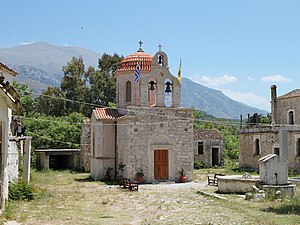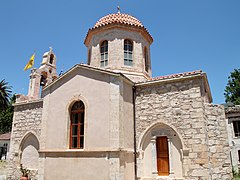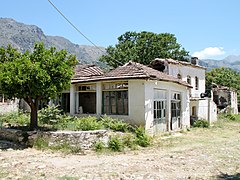Moni Asomaton
Moni Asomaton ( Greek Μονή Ασωμάτων , Monastery of Angels'), also Iera Moni Asomaton (Ιέρα Μονή Ασωμάτων), is a monastery in the Amari Basin (Αμάρι), a fertile valley in the regional district of Rethymno on the Greek island of Crete . The monastery is currently uninhabited, the buildings are in a partially bad state of disrepair. In contrast, the monastery church (Καθολικό Katholiko ) has been restored in recent years and the construction of another building for a future museum has begun.
location
About 22 kilometers southeast of the city of Rethymno in the middle of the Amari basin, the Asomathianos Kambos plain named after the monastery , Moni Asomaton was once the spiritual and cultural center of the region. The monastery grounds are located on the road from Agia Fotini (Αγία Φωτεινή), the capital of the municipality ( Dimos ) Syvritos , in which the monastery complex is also located, to Fourfouras (Φουρφουράς) in the neighboring municipality of Kourites to the east . The distance from Moni Asomaton to Agia Fotini is about 2.8 kilometers. The municipality of Syvritos occupies the western part of the Amari basin, which is irrigated by the small river Platy (Πλατύ) and its tributaries.
history
The exact founding date of the monastery is not known. Moni Asomaton was probably built at the end of the second Byzantine epoch of Crete (961 to 1204). The founder is a noblewoman from Chandakas (Χάνδακας), today's Heraklion , who on the advice of a monk from the nearby monastery Kaloidena (Καλόειδαινα) near Ano Meros (Άνο Μέρος) chose the location in the Amari basin for the new monastery and gave it to the Archangel Michael consecrated.
Towards the end of Crete's membership of the Republic of Venice , the monastery buildings were renewed. As the seat of the diocese of Lambi, Moni Asomaton played an important religious, national and cultural role in the resistance against foreign rule during the Ottoman period. Support for uprisings against the Ottomans in the 18th century led to the destruction of the monastery. It was abandoned at the beginning of the 20th century.
In 1927, parts of Moni Asomaton were used to found an agricultural school . Due to the metropolitan area of Lambi , Syvritos and Sfakia , based in Spili , the complex has now been reformed into a nunnery . The 28th Ephorate (supervisory authority) for Byzantine antiquities of the Greek Ministry of Culture in Rethymno is trying to restore the monastery buildings step by step.
description
The center of the monastery complex of Moni Asomaton is the cross- domed church , which has been repaired in recent years and is dedicated to the Taxiarches (leaders of the Heavenly Host ), the Archangels Michael , Gabriel and Raphael . According to tradition, the monastery church could have been built after the Byzantine reconquest of Crete by the Arabs from 961 under Nikephoros Phokas , as Nikephoros II. Byzantine emperor from 963 to 969 . Archaeological remains and finds support this assumption. In the 13th century the church was rebuilt in the Venetian-Byzantine style and provided with a wooden roof before it was given a vaulted roof in the 17th century. At the beginning of the 20th century, parts of the side walls and the church dome were destroyed.
There are four two-story buildings around the monastery church that are uninhabited and derelict. Some of these are being restored. The eastern boundary of the monastery courtyard is formed by the abbey , the abbot's house, with interesting facade decorations. On the other sides of the courtyard are the buildings with the dining room, the monks' chambers, workrooms and warehouses as well as the stables. A little away from the main courtyard of the complex in the southeast is the cemetery of the monastery, surrounded by palm trees and orchards.
In addition to a library with a collection of theological books, Moni Asomaton owned important heirlooms of holy robes, gospels , liturgical objects and valuables. Among them are the bishop's throne, wood carvings of the iconostasis and many icons. Some of the items are housed in the restored monastery church, other parts are currently being stored in the entrance building to be exhibited in a museum that will be set up in the monastery buildings in the future. After the decline of the monastery, valuable objects from the holdings of the former monastery property, such as embroidered gold, high-quality church vestments or the silver blessing cross, were often moved to other locations to be kept or exhibited there. They are now in the buildings of the Metropolitan Seat in Spili, the Preveli Monastery and the Historical Museum of Crete in Heraklion .
- Monastery views by Moni Asomaton
Church iconostasis
Individual evidence
- ↑ Sights - Rethymnon County, The Amari Valley - Asomaton Monastery. Retrieved July 20, 2010 .
- ↑ a b c d Michalis Andrianakis: Holy Monastery of Asomaton. Ministry of Culture, 28th Ephorate of Byzantine Antiquities - Fact Sheet
Web links
- Moni Asomaton. Archaeological Atlas of Crete: Archaeological Sites. Forth: Institute for Mediterranean Studies, accessed October 10, 2016 .
- Sights - Rethymnon County, The Amari Valley - Asomaton Monastery
Coordinates: 35 ° 14 ′ 33 ″ N , 24 ° 39 ′ 46 ″ E






